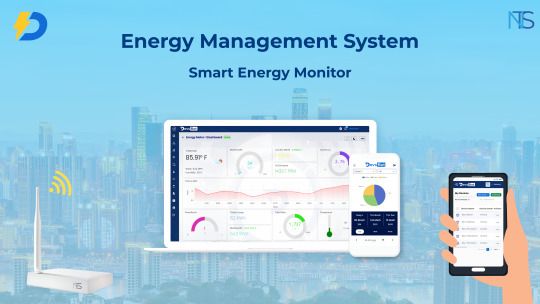#IIoTTechnology
Explore tagged Tumblr posts
Text

The Importance of Real-Time Energy Monitoring
In today's fast-paced world, energy management has become a critical concern for businesses and households alike. With rising energy costs, increasing environmental awareness, and the need for greater efficiency, monitoring energy consumption in real-time has emerged as a powerful tool for optimising usage and reducing waste. Real-time energy monitoring systems provide instant feedback on energy usage, allowing users to make timely adjustments to their consumption patterns.
Enhanced Efficiency: Real-time energy monitoring enables users to identify areas of high energy consumption immediately. By tracking energy usage in real-time, businesses can pinpoint inefficiencies and take corrective action promptly. For example, a manufacturing facility can detect equipment malfunctions or operational inefficiencies as they occur, preventing prolonged periods of energy waste.
Cost Savings: One of the most significant advantages of real-time energy monitoring is its potential for cost savings. By monitoring energy usage in real-time, businesses can identify opportunities to reduce consumption during peak hours when electricity rates are higher. Additionally, real-time monitoring allows for better load management, enabling users to schedule energy-intensive tasks during off-peak hours when electricity costs are lower.

Environmental Sustainability: Real-time energy monitoring promotes environmental sustainability by helping users reduce their carbon footprint. By identifying areas of energy waste and implementing energy-saving measures, businesses and households can minimize their environmental impact. Moreover, real-time monitoring facilitates the integration of renewable energy sources such as solar and wind power by providing insights into energy generation and consumption patterns.
Predictive Maintenance: Real-time energy monitoring systems can also facilitate predictive maintenance by detecting abnormal energy usage patterns that may indicate equipment failures or malfunctions. By identifying potential issues early on, businesses can schedule maintenance tasks proactively, reducing downtime and preventing costly repairs.
Behavioral Insights: Real-time energy monitoring provides valuable insights into energy consumption patterns and behaviors. By visualizing energy usage data in real-time, users can gain a better understanding of how their actions impact energy consumption. This awareness can lead to changes in behavior, such as turning off lights or adjusting thermostat settings, to reduce energy waste.
Regulatory Compliance: In many industries, regulatory agencies impose strict guidelines on energy usage and emissions. Real-time energy monitoring helps businesses ensure compliance with these regulations by providing accurate and up-to-date data on energy consumption. By monitoring energy usage in real-time, businesses can identify areas of non-compliance and take corrective action to avoid penalties.
Remote Monitoring and Control: With the advancement of technology, real-time energy monitoring systems now offer remote monitoring and control capabilities. Users can access energy usage data and control devices from anywhere with an internet connection, allowing for greater flexibility and convenience. This remote accessibility is especially valuable for businesses with multiple locations or distributed assets.

#esp32development#esp32electronics#esp32innovation#energyusage#iiotinnovation#iiottechnology#esp32#esp32project#connecteddevices#industrialiot
0 notes
Text
https://avench.com/iot/top-10-examples-of-industrial-iot-devices/
0 notes
Text

IOT has been on an unstoppable rise of captivating industries from all over that are transitioning into this dynamic realm. Connected to IOT, is IIOT frequently used in industries like Manufacturing, Textiles, Automotive, and Healthcare to name a few. Check out our latest blog at
as we talk about it in detail, its benefits, and how it is transforming the Manufacturing Industry.
#ParamountInstruments#IIOT#IIOTinMachines#IOT#TextileTesting#QualityAssurance#MachineLearning#IOTTrends#SmartManufacturing#ConnectedDevices#IIoTTechnology#IndustrialInternetOfThings
0 notes
Text
What are the major examples of IIoT solutions to improve waste reduction in smart manufacturing?
What are the major examples of IIoT solutions to improve waste reduction in smart manufacturing? #IIoT #Industry 4 #SmartManufacturing #IIoTtechnologies #wastereduction
If we talk about any industry, one of the primary concerns is handling waste in any form. It is important to handle toxic waste in a diligent way so that it doesn’t add up to unnecessary environmental pollution. However, inefficiency has been observed in order to handle and get rid of waste permanently and effectively. By using IIoT technologies to boost productivity in smart manufacturing,…

View On WordPress
0 notes
Photo

With billions of connections, and endless capabilities, IIOT brings to you a smart way to experience your realities.
0 notes
Text

IIoT technology is designed to offer continuous monitoring and managing of supply chains. We build robust and customized IIoT solutions to give actionable insights and proper estimates of products in the warehouse. https://bit.ly/3JiQtyS
#IIoT #iotsolutions #enterprisemobility #enterpriseapp #IIoTsolutions #iiottechnology #hireiotappdevelopers #apps #industry #business
0 notes
Photo

Industry 4.0 concept makes your enterprise ready for intensifying competition and ever-growing challenges. Our customized Industrial IoT Solutions can give your company an Industry 4.0 advantage and makes it ready for the future.
#industry40 #iiotworld #innovation #digitaltransformation #industrialautomation #industrialiot #iiottechnology #IIoTSolutions #industrialinternetofthings #automation #future
0 notes
Text

Why Energy management Team is necessary for your Industry?
The Critical Role of Energy in Economic Growth and Prosperity
Energy is a fundamental driver of economic growth and overall prosperity. Its availability and reliability are paramount concerns not only for individuals but also for organizations and nations. Presently, the majority of our energy is derived from fossil fuels, which come with significant costs and environmental impacts. Given the depletion of fossil fuel resources, future energy availability and reliability remain a major concern.
Challenges in the Indian Region
Over the past few years, there has been a noticeable increase in energy consumption, posing significant challenges for Our countries. These nations are under pressure to strategically plan and manage their energy use to ensure sustainability and economic stability.
Pro-active Energy Management Initiatives
Recognizing the urgent need for sustainable energy management, several Region have developed or are in the process of developing comprehensive energy management strategies. These strategies aim to diversify energy sources, promote the use of clean energy, and reduce energy consumption while maintaining or improving the quality of life.

Paris Agreement and India’s global warming challenges
India, under the Paris Agreement, committed to reducing its emissions intensity of GDP by 45% by 2030. This commitment aligns with the broader goal of mitigating greenhouse gas emissions outlined in the agreement.

Organizational Role in Energy Management
Organizations must align their internal policies with government initiatives to thrive in the evolving energy market. Here are key reasons why energy management should be integral to organizational activities and future plans
Cost Reduction and Growth Opportunities
Managing energy expenditures is crucial for supporting organizational growth. Continued business-as-usual practices will likely lead to increased energy costs due to rising tariffs, equipment performance degradation, and additional operational requirements. Effective energy management can reduce these costs, freeing up resources for future investments and growth.
Reduction of Risk
As countries set higher targets for energy efficiency, regulatory compliance will become mandatory. Energy costs in the Region are heavily subsidized, but tariffs are expected to rise, posing risks to organizational profitability. For instance, Indian electricity tariffs increased in January 2017, and similar hikes occurred in other cities. Pro-active energy management can reduction of these risks by improving energy supply reliability and reducing peak demand.
Improved Energy Efficiency Ratings and Branding
Organizations that prioritize energy efficiency can enhance their market position and brand reputation. Energy efficiency ratings, such as those being introduced in India, will influence tenant preferences and building competitiveness. Buildings with low energy efficiency ratings may need to offer additional benefits to attract tenants.
Standardization and Regulations
Similarly, regulatory frameworks and standards in India have been introduced to support the adoption of energy-efficient technologies. The Bureau of Energy Efficiency (BEE) has implemented energy labelling programs for appliances, which set minimum efficiency standards and encourage the use of more energy-efficient products. These initiatives are part of a broader effort to promote energy conservation and reduce the environmental impact of energy consumption.

Additional Benefits
Effective energy management offers numerous other benefits, including:
Environmental: Reduced environmental impacts and carbon emissions.
Quality of Life: Improved indoor air quality and overall health.
Management Tool: Benchmarking and tracking the efficiency of production or services.
Procurement: Enhanced evaluation of competitiveness and life cycle impacts during system upgrades.
In summary, energy management is essential for reducing costs, mitigating risks, enhancing brand reputation, complying with regulations, and achieving broader environmental and quality-of-life benefits. Organizations must actively engage in energy management to support governmental initiatives and secure a sustainable future.
#SmartEnergy#Sustainability#RenewableEnergy#EnergyEfficiency#SmartMeterRevolution#Niraltek#NiraltekTeam#InternetOfThings#ESP32#ESP32Development#ESP32Project#ConnectedDevices#IoTInnovation#IoTProject#IoTDevices#IoTSecurity#IoTApplications#IoTDevelopment#IoTTechnology#ESP32Electronics#ESP32Innovation#IIoTTechnology#IIoTInnovation#IndustrialIoT#EnergyUsage
0 notes
Text

What motivates businesses to adopt Energy Management Systems in order to revolutionize their operations?
Niraltek Solutions distinguishes itself in the industrial sector, where the optimization of energy consumption is paramount and sustainability is a primary concern, by pioneering innovation with its cutting-edge Smart Energy Monitor. This innovative solution is poised to transform energy management practices, providing businesses with unparalleled precision and efficiency in addressing the complexities of energy usage.
Energy expenditures are prominently featured on the financial statements of major industrial entities, often comprising a significant portion of their operational expenses. Recognizing this challenge, Niraltek Solutions has formulated a comprehensive approach to energy management, starting with the foundational step of assessing existing consumption levels.
The Smart Energy Monitor offers immediate insight into energy utilization across different processes within manufacturing facilities. By employing smart meters and the IoT Cloud Edge Gateway, companies can access in-depth analytics on crucial metrics such as power factor, kWh, current, and voltage. This extensive dataset serves as the cornerstone for informed decision-making, enabling organizations to identify inefficiencies and enhance energy efficiency with precision.
A standout characteristic of Niraltek’s solution is its cutting-edge data processing prowess at the Cloud's Edge. Through local data processing, latency is reduced, enabling instantaneous insights without the requirement for extensive round trips to the cloud. Moreover, this methodology bolsters data security by retaining sensitive information within the network, consequently mitigating risks without necessitating extra investments in hardware or software.
However, data itself isn't the driving force for transformation; it's the actionable insights derived from it that pave the way for progress. Niraltek Solutions' IoT platform offers a variety of visualization tools that empower businesses to transform complex data into actionable intelligence. Through intuitive charts and graphs, organizations can pinpoint peak demand periods, analyze consumption trends, and discover opportunities for improving efficiency.
The path towards energy efficiency frequently begins with pilot projects, a strategy endorsed by Niraltek Solutions. By focusing on particular processes or production lines, businesses can initiate a step-by-step transformation, reducing risk while demonstrating the tangible advantages of the Smart Energy Monitor. These pilot initiatives serve as persuasive proof of concept, establishing the groundwork for widespread adoption across the industrial sector.
As companies broaden their energy management efforts, Niraltek Solutions provides comprehensive solutions that simplify deployment and integration. The Smart Energy Monitor seamlessly merges with current business systems, including ERP and CRM platforms, along with external data sources such as weather forecasts and market prices. This extensive integration enables industrial enterprises to align their energy management initiatives with exceptional cohesion and efficiency.
Essentially, partnering with Niraltek Solutions and implementing the Smart Energy Monitor signals the onset of a new era of energy efficiency for industrial enterprises. Leveraging cutting-edge technology and actionable insights, businesses can optimize their energy consumption, trim operational costs, and lay the groundwork for sustainable expansion. In a world where every electron carries weight, Niraltek Solutions emerges as a catalyst for positive change, empowering organizations to thrive in an increasingly energy-conscious environment.
#SmartEnergy#Sustainability#RenewableEnergy#EnergyEfficiency#SmartMeterRevolution#Niraltek#NiraltekTeam#InternetOfThings#ESP32#ESP32Development#ESP32Project#ConnectedDevices#IoTInnovation#IoTProject#IoTDevices#IoTSecurity#IoTApplications#IoTDevelopment#IoTTechnology#ESP32Electronics#ESP32Innovation#IIoTTechnology#IIoTInnovation#IndustrialIoT#EnergyUsage#IoT#SmartCities#SmartMeter
0 notes
Text
#SmartMeterRevolution#niraltek#niraltekteam#InternetOfThings#ESP32#ESP32Development#esp32project#ConnectedDevices#IoTInnovation#IoTProject#IoTDevices#IoTSecurity#IoTApplications#IoTDevelopment#IoTTechnology#ESP32Electronics#ESP32Innovation#IIoTTechnology#IIoTInnovation#IndustrialIoT#smartenergy#EnergyUsage
0 notes
Text

IOT has been on an unstoppable rise of captivating industries from all over that are transitioning into this dynamic realm. Connected to IOT, is IIOT frequently used in industries like Manufacturing, Textiles, Automotive, and Healthcare to name a few. Check out our latest blog at Paramount Instruments as we talk about it in detail, its benefits, and how it is transforming the Manufacturing Industry.
#ParamountInstruments#IIOT#IIOTinMachines#IOT#TextileTesting#QualityAssurance#MachineLearning#IOTTrends#SmartManufacturing#ConnectedDevices#IIoTTechnology#IndustrialInternetOfThings
0 notes
Text

What are the most effective methods for managing power factor in your system?
`What's Power Factor?
In an energy management system, the power factor gauges the efficiency of electrical power usage. It is defined as the ratio of real power to apparent power (the total power supplied). A high power factor signifies efficient use of electrical power, which minimizes energy losses and enhances system performance.

Beer is active power (kW)—the useful power, or the liquid beer, is the energy that is doing work. This is the part you want.
Foam is reactive power (kVAR)—the foam is wasted power or lost power. It’s the energy being produced that isn't doing any work, such as the production of heat or vibration.
The mug is apparent power (kVA)—the mug is the demand power, or the power being delivered by the utility.
Understanding Low Power Factor?
A low power factor is primarily caused by inductive loads, including motors, transformers, and lighting ballasts, which draw reactive power. This reactive power is essential for generating and sustaining magnetic fields but does not contribute to useful work, increasing apparent power and consequently lowering the power factor. Moreover, harmonics from nonlinear loads, such as electronic devices and variable frequency drives, further reduce the power factor by introducing additional reactive power.
Benefits of High Power Factor
A high power factor decreases the apparent power and current drawn from the source, which can lower energy bills as some utilities impose charges for low power factor or provide incentives for maintaining a high power factor. It enhances voltage regulation and stability, increases system capacity and efficiency by reducing losses and heating, and lessens the effects of harmonics, thereby improving overall power quality.Benefits of Power Factor

Measuring Power Factor
Power factor is measured using a power meter or analyzer that monitors real, reactive, and apparent power, or with a power factor meter for direct readings. Measurements should be taken at various points in the system and at different times to account for load variations.
Correcting Low Power Factor
The most effective way to correct a low power factor is by installing power factor correction devices such as capacitors or synchronous condensers. These devices provide reactive power locally, reducing the flow of reactive power and improving the power factor. Depending on the load characteristics and desired power factor levels, they can be installed centrally or near specific inductive loads.
Controlling Power Factor Correction Devices
Power factor controllers, which can be either manual or automatic, are used to manage correction devices. Manual controllers rely on human adjustments based on meter readings, whereas automatic controllers use sensors and microprocessors to adjust devices. Automatic controllers can also be programmed to optimize performance under varying load conditions.
Optimizing Power Factor Management
Optimizing power factor management requires balancing cost, performance, maintenance, and safety. Essential practices include regular evaluation and adjustment, proper maintenance to prevent overloading and overheating, and compliance with utility codes and standards. This comprehensive approach ensures improved efficiency, stability, and cost-effectiveness of your electrical system.
#SmartEnergy hashtag#Sustainability hashtag#RenewableEnergy hashtag#EnergyEfficiency hashtag#SmartMeterRevolution hashtag#Niraltek hashtag#NiraltekTeam hashtag#InternetOfThings hashtag#ESP32 hashtag#ESP32Development hashtag#ESP32Project hashtag#ConnectedDevices hashtag#IoTInnovation hashtag#IoTProject hashtag#IoTDevices hashtag#IoTSecurity hashtag#IoTApplications hashtag#IoTDevelopment hashtag#IoTTechnology hashtag#ESP32Electronics hashtag#ESP32Innovation hashtag#IIoTTechnology hashtag#IIoTInnovation hashtag#IndustrialIoT hashtag#EnergyUsage hashtag#IoT hashtag#SmartCities hashtag#SmartMeter hashtag#powerfactor
0 notes
Text
#iiotinoil&gasindustry#iiottechnology#iiotapplications#iotinindustrialautomation#bestembeddedsoftwarecompanyinbangalore#embeddedsystems#avenchsystems
0 notes
Text
0 notes